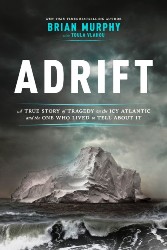 Pirates and Privateers Pirates and Privateers
The History of Maritime
Piracy
Cindy Vallar, Editor
& Reviewer
P.O. Box 425,
Keller, TX 76244-0425
    
Books for
Adults ~ Disasters, Mutinies, & Shipwrecks

Adrift
A True Story of Tragedy in the Icy Atlantic – and the
One Who Lived to Tell About It
by Brian Murphy with Toula Vlahou
Da Capo, Sept 4 2018, ISBN 978-0-306-90200-0, US $27.00
/ CAN $35
Also available in other formats
    
Ice in
the North Atlantic in winter is normal, but when
ships put into ports along the east coast of North
America in 1856, those aboard report alarming
sightings. Not only are icebergs and ice slabs far
more numerous and farther south than usually found,
they are huge. Some are described as being wider
that New York’s Central Park and taller than the
clock tower of London’s Westminster Palace once
these are completed. They prove equally dangerous.
Between January and March, some 830 men, women, and
children perish and their ships vanish. From the
four largest of these vessels, only one man
survives.
The 1850s was a decade of turbulence – the Crimean
War and conflicts between those favoring slavery and
those who did not – and change. The heyday of sail
had ebbed, giving rise to steamships that were
faster and more luxurious and not dependent on the
wind to propel them from one location to another.
Few emigrants could afford these new vessels, so
they travelled aboard wooden sailing ships to arrive
at their destinations. One such vessel was John
Rutledge, a packet ship christened in
Baltimore, Maryland just five years before she left
Liverpool, England for New York City on 16 January
1856.
Howland & Ridgway owned John Rutledge
and hired Alexander Kelley to captain her.
Although he had served on packet ships before, this
was his first time in command on a transatlantic
crossing. The passage to London went smoothly and
among those who sailed with him were half-owner
James Lawrence Ridgway, Alexander’s wife Irene,
first mate Samuel Atkinson and his wife, boatswain
William Ryan, and able seaman Thomas W. Nye. The
last was not yet twenty-two but came from a long
line of New Bedford sailors, some of whom were
well-known among the merchant trade. When it came
time to return to New York, Kelley persuaded Irene
to remain in Liverpool until spring, and Ridgway
chose to sail home to his family aboard Pacific,
a luxury steamship that would leave later but arrive
earlier in New York. Several new sailors joined the
crew, among them John Daley from Scotland. Aside
from her cargo, John Rutledge carried
steerage passengers, including William Henderson and
his family: a wife, two sons and two daughters
(ranging in age from five to sixteen), as well as
his sister and niece who was one year old.
When John Rutledge set sail,
Captain Kelley was aware of the ice reports, but not
having the advantage of today’s technology, the
information they contained was outdated. A month
later, he realized that navigating the North
Atlantic would take much longer than anticipated
because of the proliferation of ice and the frequent
storms the ship encountered. Four days later, on 20
February, the packet ship hit an iceberg and began
taking on water. Unable to stop the flow, everyone
was ordered to abandon ship. Not everyone got off,
although many did. Those in the lifeboats hoped and
prayed that another ship would soon come to their
rescue.
This book is a heartrending and compelling account
of shipwreck and survival. Maps, illustrations,
occasional footnotes, an explanation of vessel types, a family tree, a
bibliography, and an index further enhance the
reading experience. Murphy, a journalist for The
Washington Post, pieced together the story of
what happened and the people involved from family
archives, civil and church documents, shipping
ledgers, interviews, and published material found in
collections in Europe and the United States. Much of
the dialogue is skillfully imagined – fully
explained in his introduction – and, when combined
with the personal histories and period details,
vividly recreates life and sailing in the middle of
the 19th century. His primary purpose is to tell the
story of one ship and the people aboard her, yet a
secondary goal is for the book to serve as an elegy
to all the forgotten men, women, and children who
lose their lives. He accomplishes both with dignity
and passion. Adrift is so riveting that
even in the midst of summer heat, the wintry cold
seeps so deeply into your bones that not even the
warmest wool will dispel the bleak aloneness of
being surrounded by water and ice in a small boat
where the only other occupants are the dead.
Review
Copyright ©2018 Cindy Vallar

Click to contact me
Background image compliments
of Anke's Graphics |

